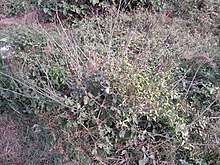Achyranthes aspera
| Achyranthes aspera | |
|---|---|
 | |
| Scientific classification | |
| Kingdom: | Plantae |
| (unranked): | Angiosperms |
| (unranked): | Eudicots |
| (unranked): | Core eudicots |
| Order: | Caryophyllales |
| Family: | Amaranthaceae |
| Genus: | Achyranthes |
| Species: | A. aspera |
| Binomial name | |
| Achyranthes aspera | |
Achyranthes aspera (common names: chaff-flower,[1] prickly chaff flower,[2] devil's horsewhip,[3] Sanskrit: अपामार्ग apamarga) is a species of plant in the Amaranthaceae family. It is distributed throughout the tropical world.[4] It can be found in many places growing as an introduced species and a common weed.[5] It is an invasive species in some areas, including many Pacific Islands environments.[6]
Uses
The juice of this plant is a potent ingredient for a mixture of wall plaster, according to the Samarāṅgaṇa Sūtradhāra, which is a Sanskrit treatise dealing with Śilpaśāstra (Hindu science of art and construction).[7]
It is one of the 21 leaves used in the Ganesh Patra Pooja done regularly on Ganesh Chaturthi day.
Traditional medicine
Achyranthes aspera has occupied a pivotal position in Indian culture and folk medicine. Since ancient times the tribal and rural people of India commonly use this herb in various disorders.

The 1889 book 'The Useful Native Plants of Australia’ records that this plant was found "in all the tropical and sub-tropical regions of the old world. The herb is administered in India in cases of dropsy. The seeds are given in hydrophobia, and in cases of snake-bites, as well as in ophthalmia and cutaneous diseases. The flowering spikes, rubbed with a little sugar, are made into pills, and given internally to people bitten by mad dogs. The leaves, taken fresh and reduced to a pulp, are considered a good remedy when applied externally to the bites of scorpions. The ashes of the plant yield a considerable quantity of potash, which is used in washing clothes. The flowering spike has the reputation in India (Oude) of being a safeguard against scorpions, which it is believed to paralyse. (Drury.)"[8]
In Uttar Pradesh, the plant is used for medicinal purposes, especially in obstetrics and gynecology, including abortion, induction of labor, and cessation of postpartum bleeding.[9]
The Maasai people of Kenya use the plant medicinally to ease the symptoms of malaria.[10]
Chemical constituents
Achyranthes aspera contains triterpenoid saponins which possess oleanolic acid as the aglycone. Ecdysterone, an insect moulting hormone, and long chain alcohols are also found in Achyranthes aspera.[11]
Other chemical constituents such as achyranthine, betaine, pentatriacontane, 6-pentatriacontanone, hexatriacontane, and tritriacontane are also present.[12]
Names
Achyranthes aspera has different names in various languages:[13][14]
- Sanskrit: Adhoghanta, Adhvashalya, Aghamargava, Aghata, Apamarga, Apangaka, Chamatkara, Dhamargava
- Hindi: Apang, Chirchra, Chirehitta,Latjira, Onga
- Nepali: Datiwan
- Assam: Apang
- Bengali: Apang
- Gujarati: Safed aghedo, Anghadi, Andhedi, Agheda
- Kannada: Uttaranee
- Malayalam: Kadaladi, Katalati
- Manipuri:
Khujum Pere, Khujum Pere
- Marathi: Aghada, Aghara, Pandhara-aghada
- Myanmar: Kyet Mout Sue Pyan
- Persian: Kharevazhun
- Punjabi: Kutri
- Tamil: Nayurivi, Shiru-kadaladi
- Telugu: Antisha, Apamargamu, Uttareni
- Sinhalese: Gaskaralheba, Karal seba
- Indonesia: Jarong
- Arabian: Atkumah
- French: Achyranth a feuilles rudes, collant, gendarme
- Spanish: Mosotillo, rabo de gato, rabo de chango, rabo de raton
- Afrikaans: Grootklits, langklitskafblom
- Tocharian B: apamārga, viśīr[15]
- Vietnamese: Cây cỏ xước
- Somali: sariibiye
References
- ↑ "BSBI List 2007". Botanical Society of Britain and Ireland. Archived from the original (xls) on 2015-01-25. Retrieved 2014-10-17.
- ↑ Flowers of India
- ↑ USDA Plants Profile
- ↑ Flora of North America
- ↑ "Achyranthes aspera". Germplasm Resources Information Network (GRIN). Agricultural Research Service (ARS), United States Department of Agriculture (USDA). Retrieved 2018-01-02.
- ↑ Pacific Islands Ecosystems at Risk
- ↑ Nardi, Isabella (2007). The Theory of Citrasutras in Indian Painting. Routledge. p. 121. ISBN 1134165234.
- ↑ J. H. Maiden (1889). The useful native plants of Australia : Including Tasmania. Turner and Henderson, Sydney.
- ↑ Khan, A. V. and A. A. Khan. Ethnomedicinal uses of Achyranthes aspera L. (Amaranthaceae) in management of gynaecological disorders in western Uttar Pradesh (India). Archived November 24, 2010, at the Wayback Machine. Ethnoleaflets.
- ↑ Bussmann, R. W.; Gilbreath, G. G.; Solio, J; Lutura, M; Lutuluo, R; Kunguru, K; Wood, N; Mathenge, S. G. (2006). "Plant use of the Maasai of Sekenani Valley, Maasai Mara, Kenya". Journal of Ethnobiology and Ethnomedicine. 2: 22. doi:10.1186/1746-4269-2-22. PMC 1475560. PMID 16674830.
- ↑ Indian Herbal Pharmacopia Vol. II, Page-5.
- ↑ Saurabh Srivastav; Pradeep Singh; Garima Mishra; K. K. Jha; R. L. Khosa (2011). "Achyranthes aspera-An important medicinal plant: A review". J. Nat. Prod. Plant Resour. 1 (1): 1–14.
- ↑ Dr. K. M. Nadkarni's Indian Materia Medica, Volume 1, Edited by A. K. Nadkarni, Popular Prakashan, Bombay, 1976, pp. 21-2.
- ↑ "Archived copy" (PDF). Archived from the original (PDF) on 2014-03-27. Retrieved 2015-09-28.
- ↑ "Etymological Dictionary of Tocharian B". BrillOnline Dictionaries. Retrieved 3 June 2017.
External links
| Wikimedia Commons has media related to Achyranthes aspera. |